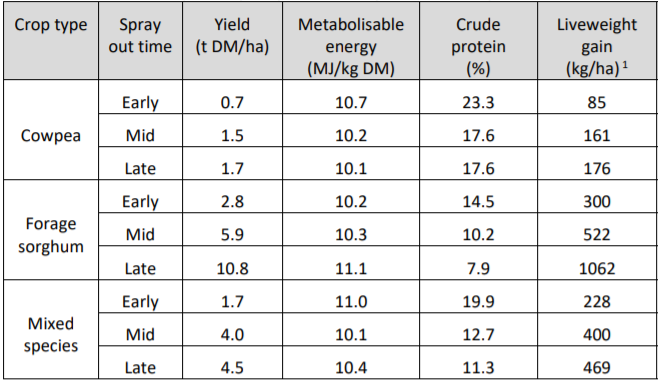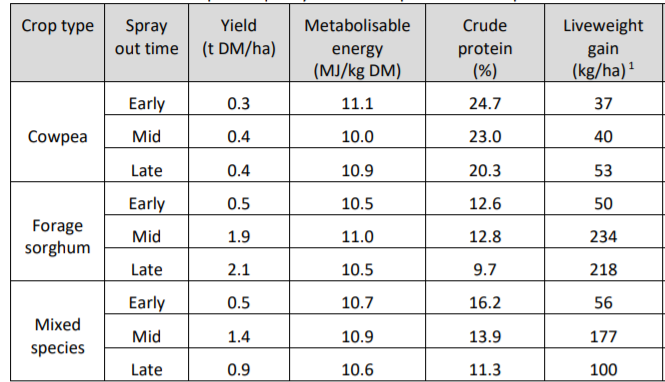Management options for unsown paddocks
10 Jul 2023
By Rohan Leach, Mixed Farming Advisor
**Please note all prices and gross margins are indicative only and should only be used as a guide**
For many, 2023 has been another interesting season, with some areas in our south and east experiencing good autumn breaks and timely, follow up winter rainfall. While in the north and west of our region, conditions remain disappointingly dry.
For the past three years, I have addressed the issue of management options for unsown paddocks. However, each year there has been a differing reason for unsown paddocks across our region, including both too wet and too dry! The good news is there are still options out there for managing paddocks that have yet to be sown to crop.
- Late sown winter crop
July-sown wheat will generally be lower yielding than those crops that went in on time (GRDC Fact Sheet, 2011). This is due to a shorter growing season and the crop flowering and ripening during warmer spring months. Your best bet is to sow quick maturity varieties such as Spitfire, Mustang, Vixen or Condo which are all suited to a late June and, in some cases, early July sowing. Later sown species like barley or chickpeas are typically the only option for a very late sowing, while some producers may choose to put in forage cereals for a hay option. In this situation, sowing rates must be increased by 30-40% to compensate for the reduced tillering of cereals due to seasonal conditions. The end of July will be the end of this window.
Optimistically, we would be looking at yields of around 1.5-2.5 tonnes per hectare (ha) for barley crops sown in July, depending on your historical average yield. As can be seen in Table 1, with high grain prices and input prices back on what they were last year, we are looking at a small profit at our lower scale of 1.5t/ha yield. If the paddocks are bare, due to cultivation or burning, and you want to restore some groundcover, then sowing crop may be especially valuable in this instance. While the crop yields will be lower than a barley crop sown in May or June, the critically important ground cover will be restored.
Table 1: Late sown winter crop - Barley yielding @ 1.5 t/ha @ $326/t
| Expense/ha | Income/ha | ||
Sowing | $ 40.00 | Grain | $ 490.00 |
Starter fertiliser (60kg MAP @ $750/t) | $ 55.00 | ||
Urea topdress (80kg Urea @ $700/t) | $ 56.00 | ||
Seed (80kg @ $500/t) | $ 40.00 | ||
Pesticides, herbicides, fungicides | $ 75.00 | ||
Sprayer running costs (x3 @ $15/ha) | $45.00 | ||
Harvest (stripping, grain haulage) | $80.00 | ||
Total | $ 390.00 | $ 490.00 |
- Cover Crop
As mentioned above, sowing a cover crop, primarily to establish ground cover on a bare paddock, is an option. Additionally, using a legume crop such as field peas, vetch or faba beans, will provide nitrogen (N) fixation of around 25kg N fixed per tonne of dry matter (DM) grown. Sown in late winter a crop like this could be expected to grow around 3t/ha of DM, fixing around 75kg of N per ha.
To prevent the loss of this fixed N through the development of crop seed, the legume crop is sprayed out during flowering to stop the crop reproductive development (i.e., setting seed). This is called a “brown manure” crop and is a good option when persistent or herbicide resistant weeds are impacting a paddock. While providing ground cover and storing N, as can be seen in Table 2, it is an expensive option with current urea prices (e.g., $700 per tonne). However, the benefit to the subsequent crop in groundcover, available N and weed control cannot be understated and adds value economically that is hard to quantify.
Table 2: Late sown legume cover crop - fixing 75kg N @ $700/t for urea
Expenses/ha | Income/ha | ||
Sowing | $ 40.00 | Nitrogen Fixation | $ 114.00 |
Fertiliser | $ 60.00 | (urea** at $700/t | |
Seed | $ 72.00 | or $1.52/kg N) | |
Fallow spray* | $ 30.00 | ||
Total | $ 202.00 | $ 114.00 |
- Long Fallow
A long fallow is typically used to store soil moisture and soil N in more marginal cropping systems and is a risk reduction tool (Cann & Hunt, 2018). However, it could be used this year by producers, dependent on their situation. A long fallow for next year’s winter crop provides similar benefits as a cover crop but is a lower cost option. Crop stubbles, ideally, will have been conserved as reduced ground cover for long periods increases the risk of soil erosion.
The efficacy of a long fallow is strongly dependent on soil type. Clay soils will hold onto stored soil moisture more readily during a long fallow, when compared with light, sandy soils. Current soil moisture must also be assessed for the usefulness of a long fallow. Paddocks being considered for long fallows may already have moderate to high levels of stored soil moisture due to a wet 2022 and running a long fallow in these instances may contribute to rising water tables and poor water use efficiency for the subsequent crop.
In terms of costs, a fallow spray at the end of spring, to stop weed seed set, is typically all that is needed in the CW. However, in herbicide resistant weed populations, a double-knock herbicide strategy may need to be employed. For around $30/ha per pass (including contract spray rates), long fallowed paddocks are likely to yield more than continuously cropped paddocks, with yield increases of 60-80% observed on long fallows (Cann & Hunt, 2018), albeit in lower yielding situations.
- Summer Crop - Grazing
Another option is to give up on a winter solution and start preparing the paddock for a summer crop. As the risk is too high for most producers in the CW for a summer grain crop, this article will look primarily at grazing sorghum. This isn’t to rule out summer grain crops as an option for you, however the different market factors and crop types make this option too big to look at here.
In a recent study, conducted by McMaster, Stevenson & Strahorn (2020) at sites in Parkes and Canowindra during the summer of 2018/2019, forage sorghum proved to be very profitable for grazing enterprises. This was despite the dry conditions that summer, with well-below long-term average rainfall recorded.
High dry matter (DM) yields of between 2.8-10.8 tonne were observed at Canowindra (Table 3) and at the drier site at Parkes (Table 4), DM yields of 2.1 t/ha. Even in the dry situation at Parkes, 234kg of lamb liveweight gain potential was calculated per hectare. This could provide growers up to $700/ha (gross) with current lamb prices (~$3/kg liveweight) and makes a summer grazing option financially attractive.
Table 3: Cover crop feed quality results and potential lamb production results – Canowindra

Source: McMaster et al. (2020)
Another facet this study considered was the impact of a summer grazing crop on the subsequent 2019 wheat crop. It will come as no surprise that within the Parkes site this summer grazing crop came at the cost of a winter grain crop in 2019. A reduction from a summer fallow yielding 0.77t/ha to the forage sorghum treatment only yielding 0.07 t/ha, highlights the cost of this summer feed. In the higher rainfall situation at Canowindra (which may be argued to be a more average year for the CW), the summer fallow treatment yielded 2.93t/ha for the subsequent wheat crop. The forage sorghum treatment recorded a significantly reduced yield of 1.13t/ha.
Table 4: Cover crop feed quality results and potential lamb production results – Parkes.

Source: McMaster et al. (2020)
The conclusion for this option is that you cannot have your cake and eat it too! You will have a good grazing crop over summer at the cost of a good winter crop next year. Additionally, this does not consider paddock sizes or a producer’s ability to source and access livestock.
Final Word
While there are many options available to producers, everyone's individual risk profile and capacity to undertake these options is different. A long fallow will typically be your lowest risk option. This allows you to cut your losses and hope for an early sowing opportunity next year to try and regain some of the lost opportunity observed this year. A summer grazing crop will be your highest risk option however it provides you an opportunity to capitalise on potentially high soil moisture in spring. If you have light soils that may not carry stored soil moisture over until next autumn, this may be your best option.
The answer may lie in farmers walking a fine balance between utilising a number of these options. For more specific advice please contact your trusted advisor, agronomist or give me or one of our LLS Ag Advisory team a call.
Rohan Leach | 0417 021 795 | rohan.leach@lls.nsw.gov.au
Bibliography
Cann D. & Hunt J. (2018) ‘Long fallows maintain whole-farm profit and reduce risk in the Mallee’. Grains Research and Development Corporation Research Update. Accessed from: https://grdc.com.au/resources-and-publications/grdc-update-papers/tab-content/grdc-update-papers/2018/02/long-fallows-maintain-whole-farm-profit-and-reduce-risk-in-the-mallee
McMaster C., Stevenson A. & Strahorn S. (2020) ‘Summer cover crops in short fallow - do they have a place in central NSW?’ NSW Department of Primary Industries, Orange. Accessed from: https://grdc.com.au/resources-and-publications/grdc-update-papers/tab-content/grdc-update-papers/2020/02/summer-cover-crops-in-short-fallow-do-they-have-a-place-in-central-nsw
GRDC Fact Sheet (2011) ‘Time of Sowing, Impact on yield and quality of wheat’. Grains Research and Development Corporation. Accessed from: https://grdc.com.au/__data/assets/pdf_file/0019/100738/grdcfstimeofsowingsouthpdf.pdf.pdf